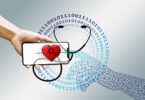[et_pb_section bb_built=”1″][et_pb_row][et_pb_column type=”4_4″][et_pb_text _builder_version=”3.13.1″]
The electronic medical record (EHR), also known as computerized clinical history (HCI), is nothing more than the automatic recording of social, preventive and medical data of a patient, obtained directly or indirectly and constantly updated.
The incorporation of new information technologies in health services and the development of information systems for the management of clinical data, such as the Electronic Health Record, has contributed to an increase in the quality and efficiency of health services and a improvement in the safety of patient care.
The electronic medical record supposes incorporating the Information and Communication Technologies (ICT) in the core of the health activity. This has as a consequence that the story stops being a record of the information generated in the relationship between a patient and a professional or a health center, to be part of an integrated clinical information system.
Information and communication technologies (ICT) in the health sector were initiated in the laboratory or radiology, to carry out clinical reports, with the aim of reducing the use of paper and currently all centers use computer support for the creation of reports. However, the concept of electronic medical record (EHR) goes beyond pure writing on a data computer.
The health staff uses a particular vocabulary, which is known as medical terminology, to facilitate communication with other health professionals. In healthcare practice, the classification criteria that are of interest are those that allow defining a prognosis and the type of treatment that should be applied.
The medical language also hinders its function as a tool for information retrieval. For this reason, in the medical information systems, the use of standardized artificial languages called by the documentalists has been resorted to. This language includes codes of labels and what is important in documentary languages is its structuring according to conceptual criteria.
This document GDPR of its acronym in English “General Data Protection Regulation”, aims to serve as a guide to health professionals and managers in their work to ensure the safety and protection of health data.
These and other innovations are now possible in Pharmamedic.
[/et_pb_text][/et_pb_column][/et_pb_row][/et_pb_section]







